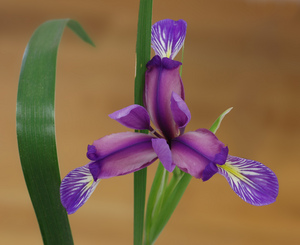To gaze an Iris, we experience a profound realization of the color spectrum. From the Iris of the eye to the Iris of the garden we are engulfed in the word’s meaning, which is Greek for Rainbow. The genus Iris of the iridaceous family, quite literally represents a rainbow of nearly 300 different flowers. Fittingly, we can visually enjoy this plentiful species from the Iris of the human eye, where light adjusts for the pupil, also displaying eye color. The Iris is sometimes given the title of “eye of heaven” as well.
From the anatomy of the eye to floral anatomy, the Iris is of keen interest to the botanical world. Its perfect representation of the inner and outer workings of a flower makes it the ideal subject for visualizing nature in play. As the Encyclopedia Britannica defines, the iris flower is of special interest as an example of the relation between the flower’s shape and how insects transport pollen. Though, that’s exploring the complex bloodline of nature, and the cultural heart of the Iris is stronger still.
The Greek goddess Iris is, as her name befits, the goddess of rainbows; a communicative messenger who serves the bond between the gods and humans. She was known to travel by the wind, and thus her marriage was to Zephyrus, god of the west wind. Like our eyes are linked to the beauty of flowers by color, the goddess Iris carried the color of humanity for the Gods to see. For the clouds, Iris gathered water from the gods of the sea, her presence revealed by rainbows, as she carried her message on the winds.
The naming of the Iris flower is tribute to the inspiring nourishment the Greeks attributed to the goddess. The flower itself is also an inspiration to a prevalent cultural symbolism; the fleur-de-lis. It’s a reoccurring symbol that stems from 12th century France into modern usage as official emblems in Quebec, Canada and New Orleans (as seen on the Saint’s football team). The Fleur-de-lis is styled after the Yellow Iris from Western Europe, yet the flower’s unmistakable anatomy can be seen across the genus. This familiar structure can be traced as far back as the ancient Egyptians as well, perhaps even depicted on the brow of the Sphinx herself.
Being that the Iris has such a rich symbolism, giving or receiving the flower can embrace a diverse, albeit meaningful gesture. Iris the goddess was a messenger; hence the flower can send a message of understanding, eloquence and love for humanity. The prominent three petal structure of the Iris can symbolize the triumvirate of faith, valor and wisdom.
The three most popular colors seen with Iris flowers, deep purple, blue, yellow or white, can represent different messages. Purple, perhaps the most common Iris seen, is often a symbol of wisdom and an offering of compliments. A blue Iris may convey a message of faith and hope and yellow contains a message of passion, where white holds it typical symbol of purity. More purely, outside all of this meaningful symbolism, the Iris is also the birth flower for the month of February.
Should you bring or receive the eloquence of cut Iris flowers into your life, you can typical expect a vase life of 3 – 5 days, perhaps more. The Brooklyn Botanic Garden guide to cut flower care has some tips on care: The Iris is a soft stem flower and “should be cut where the green on the stem starts-just above the white bulb.” It’s best to keep Irises in cold water, as they bloom when the air and ground are at lower temperatures.
If you’re in the Parker, Colorado area, Mainstreet Flower Market is having a special on Irises this week, which is a homegrown, local flower from Stevens and Sons






